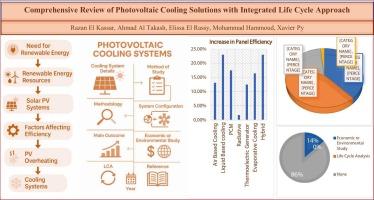光伏冷却系统综述整合技术,经济和环境方面,包括生命周期评估
IF 6
2区 工程技术
Q2 ENERGY & FUELS
引用次数: 0
摘要
转向可再生能源对于减少全球二氧化碳排放和提供长期能源安全至关重要。在这两个方面,光伏系统都占据了这一范式转变的中心位置。然而,加热通常会降低光伏系统的效率,因此冷却措施至关重要。本文回顾了近五年来太阳能电池板冷却技术的最新发展,重点关注了包括在整个生命周期评估(LCA)中的经济和环境研究。综述了空气冷却技术、液体冷却技术、相变材料冷却技术、辐射天空冷却技术、热电发电机冷却技术、珀尔帖效应蒸发冷却技术和混合冷却技术。与以往的研究不同,本文调查了所有已知的研究,整合了生命周期方法。它超越了热性能的好处,考虑了每种冷却策略的经济和环境影响。例如,在阳光充足的条件下,热电发电机与PCM的结合使发电量增加了20%至30%。一个更有趣的发展是,将PCM与水冷却技术相结合的混合技术,已经实现了22.8%的总体电气效率提高。在干燥地区,蒸发冷却系统可使50 W多晶组件的温度降低22.7%,并将产生的输出功率提高16.3 W。纳米流体冷却技术使PV表面温度降低了23.14%,效率提高到20.2%。然而,在全面的经济,环境和LCA评估方面仍然存在重大差距,需要进一步调查冷却系统的可行性和长期影响。本文章由计算机程序翻译,如有差异,请以英文原文为准。

Photovoltaic cooling systems review integrating technical, economic, and environmental dimensions encompassing life cycle assessment
The switch to renewable energies is of key importance for both reducing global CO2 emissions and offering long-term energy security. In both regards, photovoltaic systems occupy the central position in this paradigm shift. However, heating usually reduces the efficiency of a photovoltaic system hence making cooling measures paramount. This paper reviews the recent developments in cooling techniques used with solar panels within the last five years, necessarily focused on economic and environmental studies included in an entire life cycle assessment (LCA). The cooling techniques have been reviewed: air-based, liquid-based, phase-change material (PCM), radiative sky cooling, thermoelectric generators, Peltier effect evaporative cooling, and hybrid systems. This article, unlike prior studies, investigates all known studies, integrating the life cycle approach. It goes beyond benefits in thermal performance to consider the economic and environmental implications of each cooling strategy. For instance, the combined thermoelectric generators with PCM increased electrical power generation by 20 to 30 % in sunny conditions. A more interesting development is that hybrid techniques using PCM in conjunction with water-cooling techniques, have achieved an overall improvement of 22.8 % in electrical efficiency. The evaporative cooling systems had the potential to drop temperature by 22.7 % and increase the generated output power by 16.3 W for a polycrystalline 50 W module in a dry region. The nanofluid cooling techniques decreased the PV surface temperature by 23.14 %, increasing their efficiency to 20.2 %. However, there still significant gaps in thorough economic, environmental, and LCA assessments necessitating further investigation into feasibility and long-term impacts of cooling systems.
求助全文
通过发布文献求助,成功后即可免费获取论文全文。
去求助
来源期刊

Solar Energy
工程技术-能源与燃料
CiteScore
13.90
自引率
9.00%
发文量
0
审稿时长
47 days
期刊介绍:
Solar Energy welcomes manuscripts presenting information not previously published in journals on any aspect of solar energy research, development, application, measurement or policy. The term "solar energy" in this context includes the indirect uses such as wind energy and biomass
 求助内容:
求助内容: 应助结果提醒方式:
应助结果提醒方式:


